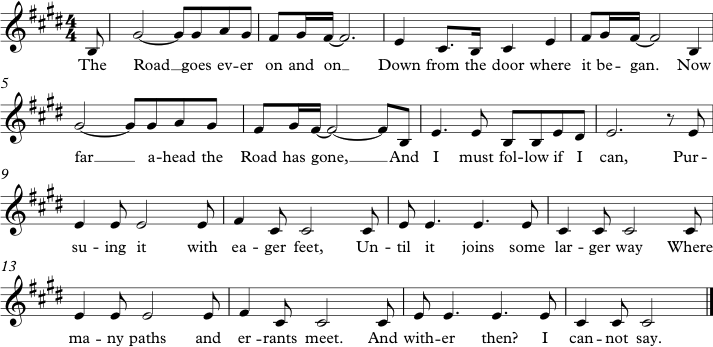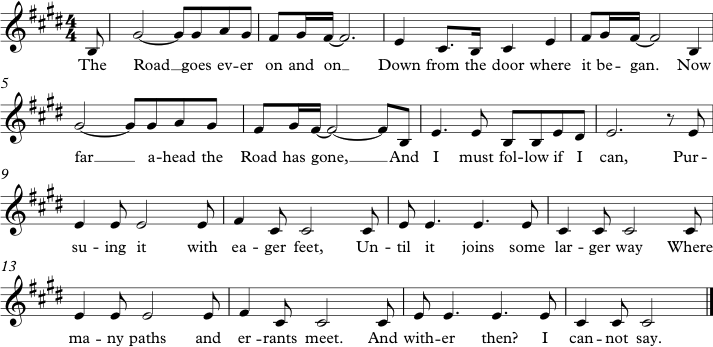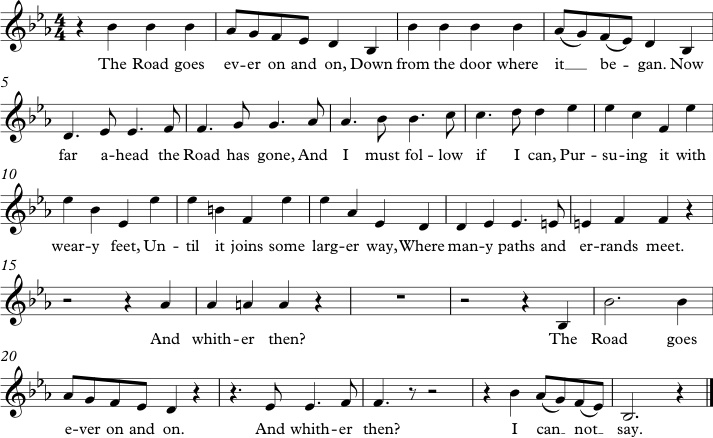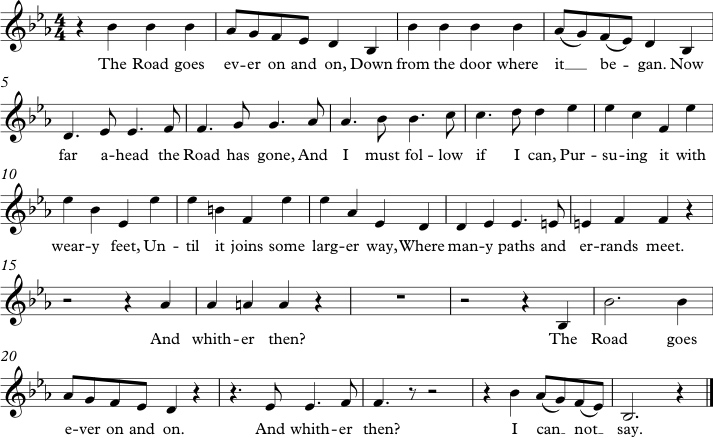Tolkien Ensemble, The Old Walking Song (I), TE CD 1, Track 1, 5:09.
Tolkien Ensemble, The Old Walking Song (II), TE CD 1, Track 3, 1:13.
Tolkien Ensemble, The Old Walking Song (III), TE CD 4, Track 17, 3:33.
Donald Swann, The Road Goes Ever On, Swann, 1.
Howard Shore, Bag End, LotR FotR CD 1, Track 3, 4:36, starts at 0:20.
The Lord of the Rings Musical, The Road Goes On, LotR M, Track 2, 4:51.
Tolkien Ensemble, The Old Walking Song (II), TE CD 1, Track 3, 1:13.
Tolkien Ensemble, The Old Walking Song (III), TE CD 4, Track 17, 3:33.
Donald Swann, The Road Goes Ever On, Swann, 1.
Howard Shore, Bag End, LotR FotR CD 1, Track 3, 4:36, starts at 0:20.
The Lord of the Rings Musical, The Road Goes On, LotR M, Track 2, 4:51.
The Old Walking Song, the very first song to be encountered by the reader in The Lord of the Rings, is without doubt the most well-known song from the book, primarily because of it being the first one and thus the most likely to still get read. It is sung by Bilbo when leaving the Shire after the “long-expected party” and, with textual alterations, sung repeatedly later by Frodo. The origin of the song is not completely clear: One might argue that it is derived from a similar poem spoken by Bilbo at the end of The Hobbit. Nothing suggests that he has invented it himself and the text clearly says that he “said” it. This might, however, lead us back to Martin and his observation of folk singers rarely distinguishing between singing and speaking – so if Bilbo is here described “saying” what would clearly be a good walking song, there is no reason to assume that even if he did not sing it when coming home, he would not make a song out of it later on. After all he had sixty years of time until the events of The Lord of the Rings to find a suitable melody.
It is therefore likely that Bilbo wrote the song present in The Lord of the Rings based on his idea from when he returned in The Hobbit. The song is then again spoken by Frodo when crossing the border of the Shire and a final time by Bilbo as an old Hobbit in Rivendell. The first two versions are nearly identical, with the only change being the line “Pursuing it with eager feet” in Bilbo’s version, in which Frodo replaces “eager” with “weary”. This hardly qualifies as a completely new version. Frodo plain and simple replaced the word because his feet hurt and it fitted the occasion.
The Road goes ever on and on
Down from the door where it began.
Now far ahead the Road has gone,
And I must follow, if I can,
Pursuing it with eager / weary feet,
Until it joins some larger way
Where many paths and errands meet.
And whither then? I cannot say.
(LotR, 73)
Bilbo’s version from Rivendell, however, is noticeably different:
The Road goes ever on and on
Out from the door where it began.
Now far ahead the Road has gone,
Let others follow it who can!
Let them a journey new begin,
But I at last with weary feet
Will turn towards the lighted inn,
My evening-rest and sleep to meet.
(LotR, 987)
It is best described as a textual adaption of the earlier song. The new text only uses the first three lines of the original poem, but by this (and presumably by using the same melody) Bilbo clearly draws upon the knowledge of the original song on the part of the reader. We may describe this new version as a musical summing-up of his part in the story to Frodo: He, as the Ring-bearer and the one who was responsible for the task of destroying it, has successfully taken over from Bilbo, who was originally responsible for the ring since the time he found it in The Hobbit. Figuratively speaking, Bilbo confirms in retrospect having passed the torch to his nephew. Indeed with him giving his old Mithril shirt to Frodo before he goes out to destroy the ring without anyone knowing, this act is pronounced even more clearly (LotR, 278). As such, we may not just see Bilbo’s second version as the mutterings of a tired old Hobbit, but rather as an active decision to now accept that others have handled the affairs.
Arguably Bilbo may even have prepared Frodo for this all the time, subconsciously. Frodo knows Sindarin, something only very few Hobbits do and he obviously is well educated. It may even be possible that the ring itself had some part in making Bilbo help Frodo to become ready for his task: Just as the ring has kept Bilbo from ageing, he may have influenced his dealings with his nephew to ultimately make Frodo the one to bring the ring back to Sauron. And indeed Frodo would have done so – if not for Gollum. Gandalf’s quote “My heart tells me that he has some part to play yet”, (LotR, 59) may refer to him knowing such thing, or at least having an inkling that something like this may be forthcoming. For the ring, Bilbo was one tool to get back to his master as he could make sure that he raised Frodo in a way that would suit his needs – the only thing the ring did not consider is that Frodo may indeed let Gollum live, so despite Frodo ultimately succumbing to the ring, it would nevertheless be destroyed, if only by accident.
The Tolkien Ensemble has set these three versions of the song to music, all three with the same melody and similar instrumentation, listed here in book order.
transcription (excerpt): The Old Walking Song (I), TE CD 1, Track 1.
http://soundcloud.com/middle-earth-music/4-1-2-the-old-walking-song-i/s-SDGG1
The Old Walking Song (I) begins with a long plucked classical guitar introduction, with a solo violin coming in after 45 seconds, until the singer begins at 1:40. When looking at the instrumentation of the introduction, the use of a guitar poses some questions. There is no mention of guitars in the book, nor is it likely that any Hobbits played them, as a standard concert guitar would be very large indeed for a Hobbit. They could have used smaller versions, but this surely would have merited a mention by Tolkien. It is also doubtful that - if there indeed were guitars in Middle-earth - Hobbits would have kept using smaller versions without the chance of ever moving up to the full-size instruments. As with all musical instruments, the size of the guitar has developed over time and is chosen for best sound. So for a people that could never play the full-size version, it is unlikely that they would even begin using the instrument at all. If we think about which instrument the Hobbits could have used instead of the guitar, the best alternative would be an octavo mandolin, which is tuned an octave lower than the regular mandolin. The instrument is much smaller than a guitar, while still having a tonal range allowing for chordal accompaniment as well as playing melodies. We do not know about the use of octavo mandolins, either, but if indeed Hobbit music would sound like modern folk music, it would make sense to have a “guitar-like” instrument. The inclusion of a guitar in the recordings is probably due to Caspar Reiff, the composer, being a guitarist. Reiff writes that he had “always thought of the guitar sound to be very close to a semi-sized-hobbit harp” (Reiff, e-mail 2). Indeed, a harp could take the place of the guitar in hobbit songs by providing chordal accompaniment as well as playing melodic fills.
The violin coming in during the introduction fits into the instrumentation, but we may question its playing style. The Tolkien Ensemble in its version has a violin, played with little vibrato, but still played in a classical style, not the folk style that is suggested by Tolkien. Even though we know he preferred the term “fiddle” in general, he nevertheless was certainly aware of the differences in style. Apart from a sometimes slightly flatter bridge, there is no visible difference between a fiddle and a violin, so the fact that Bilbo says “fiddle” and not “violin” when the Dwarves get out their instruments at his “unexpected party” suggests that Hobbits played fiddle style, not classical style. We might at least expect a couple of double stops in the piece. Lastly the introduction is very long. The Old Walking Song, as the name implies, is sung either while walking or before departing on a journey. In both cases, such a long instrumental introduction is not very likely. We may excuse this with Reiff’s goal of presenting the songs as part of a retelling of the events of the War of the Ring in Rivendell, as outlined earlier.
When the voice comes in at 1:40, an orchestral string section accompanies the vocals until the end as a pad. This string section only makes sense in the situation of an after-the-war performance, because there is no reason to assume that at any performance of Hobbit music there was a string section present; maybe single instruments, but not a full (orchestral) section. After the poem has been sung once through, an interlude is played with violins con sordino (2:25), while the guitar and string accompaniment stays present. After this, the text is repeated identically (3:20). After that, we again hear the violin introduction, but this time accompanied by a string pad (4:07).
The whole piece is performed very slowly and with the string pad feels very much like a sad ballad. Apart from the instrumentation, which does not completely follow what we could gather of Hobbit music, the slow tempo makes this song not ideal as a walking song. The melody itself is sufficiently catchy as to be memorable on the first pass – again, one of the requirements we have detailed of Hobbit music. This version is sung when Bilbo embarks on his journey, so he supposedly is eager to go, which is also expressed in the book (“I am as happy now as I have ever been, and that is saying a great deal.”, LotR, 35). In the book, the song appears to be a happy, encouraging song, which should come across in any rendition even with the artistic license of adding an accompaniment. From the whole style of this rendition, it would better fit Bilbo’s second version of the song at Rivendell.
A guitar only accompanies The Old Walking Song (II), with identical text to the first rendition. The text is only sung once through, contrary to the Ensemble’s first version. We might well imagine this to be sung by Frodo when looking back at the Shire. The tempo is roughly the same, which still gives the song a slightly sad feel, but with the string pad missing, the song feels more like a reminiscence of the warm fire and the amenities of Bag End, not to speak of Frodo remembering Bilbo, which is exactly what the book suggests. Apart from the guitar as accompaniment, this version certainly makes sense and brings the situation from the book across nicely.
http://soundcloud.com/middle-earth-music/4-1-2-the-old-walking-song-ii/s-0UyOe
The Old Walking Song (III), Bilbo’s version as an old Hobbit in Rivendell, is identical to the very first version. As said before, this rendition fits Bilbo’s song as an old Hobbit well. The sad feel complies with a sense of regret in Bilbo not to have seen all these wonders himself, while at the same time being relieved to not have been forced to go to Mordor or to war. In Rivendell, we can even consider the presence of a string section and a solo violin. The song could have been performed at a retelling of the story of Frodo’s adventure, a reading from the Red Book, as per Reiff’s concept.
Donald Swann also set this poem to music in his song cycle The Road Goes Ever On as the first piece in the cycle. He chose the second version of the song (“weary feet”) for his piece and set it to a simple melody accompanied by a piano providing chordal harmony and most of the time doubling the melody.
excerpt: The Road Goes Ever On, Swann, 1.
Stylistically, the piece is heavily oriented towards art song and does not in any way display any specific characteristics that we could describe as belonging to Hobbit music. The melody is identically used for the Elven Hymn of Elbereth Gilthoniel, which supports the theory that it does not reflect typical Hobbit music.
Testament to its importance and popularity, The Old Walking Song also features in the motion picture adaption as well as in the stage musical. In the film, Gandalf first sings it in the first version when he comes to Bag End. Bilbo likewise just sings the first four lines of the song on-screen when leaving after his birthday party. He supposedly continues singing on, but this is not audible on-screen. Both sing it to roughly the same melody, the only difference being the third line. Because Gandalf’s version is more pronounced and is sung twice, we will use his version here:
transcription (excerpt): Bag End, LotR FotR CD 1, Track 3, from 0:20.
The tune is rhythmically easy to grasp, with a slow harmonic rhythm at the beginning – the whole first line is on the same chord (bars 1-2). Only later does the harmonic rhythm quicken. The melody is pretty catchy and works well at different speeds, making it suitable for a walking song. The song stands in the key of Eb major, most likely so it fits the key of the underscore during the scenes. There is no reason why it should regularly be played in this key by the Hobbits themselves. For a folk song it would rather be in D major. Indeed if we have the musical example of Howard Shore’s pensive setting or rural setting of the Shire theme (see Adams, 23 for details about these themes) with its use of the Irish Whistle, which is customarily tuned in D major. By having Gandalf know both the tune as well as the words, the filmmakers suggest that the song is relatively well-known, or at least that Bilbo taught it to Gandalf.
The stage adaption of The Lord of the Rings does not use the song in its original form, but has a music number called The Road Goes On, which in its text draws images from Bilbo’s song and essentially is used in the same manner.
[text continued (excerpt):]
Where it leads no-one ever knows
Don't look back follow where it goes.
Far beyond the Sun
Take the Road wherever it runs.
The Road goes on, Ever ever on
Hill by hill, Mile by mile
Field by field, Stile by stile.
The Road goes on, Ever ever on
[. . .]
[FRODO/SAM]
See the Road flows past your doorstep, calling for your feet to stray
Like a deep and rolling river, it will sweep them far away.
[ALL]
Just beyond the far horizon, lies a waiting world unknown
Like the dawn its beauty beckons, with a wonder all its own.
[. . .]
transcription (excerpt): The Road Goes On, LotR M, Track 2.
We can use this song to get a complete picture of how a Hobbit could have performed the song during travel with instrumental and vocal accompaniment. While text is only very loosely based on Tolkien’s poem, nevertheless the connection between the songs is obvious. In the musical, the song is introduced with a fiddle pattern accompanied by a bouzouki. The latter, though not mentioned by Tolkien, would be small enough to have been used by Hobbits. The introduction with its repeated figures gives a solid sense of tempo and allows the singers to join in at the right spot with a violin playing a pickup line at 0:13 with the voice beginning at 0:18. This is important for an impromptu group performance at the campfire and of course in the stage show in order for the actor to know his entry. The melody (see excerpt for the first few bars) is as catchy as the version from the films and harmonically easy, so as to facilitate singing and playing along. The musical also makes use of harmony singing, as suggested as a possible element of Hobbit music before: In the theatrical performance, there is a short two-part harmony section after the first chorus. This section is not included on the cast recording, however.
transcription (excerpt): The Road Goes On, LotR M, not on the recording.
This section could be representative of one of the vocal styles used by Hobbits, as this style of harmony singing lends itself to all catchy melodies with simple chord progressions, does not require any rehearsals and is simple enough to execute that a singer can play an instrument at the same time. In terms of adherence to the musical style of Hobbits, the song from the musical of all the renditions listed fits best, even though it uses different lyrics. In instrumentation and style it represents a typical journey song with all the attributes such a piece needs: memorable melody in a relatively narrow vocal range accessible to all singers, easy to grasp chord progressions and suitable for walking while singing.
The only word changed in Frodo’s version of the Old Walking Song, “weary” instead of “eager”, is used in the Song of Hope in the musical. In this duet between Aragorn and Arwen we find the line “And let the waking morning find the weary traveler12 returning home” (LotR M, Track 5, at 1:45). The inclusion of this word surely is no coincidence, and suggests that the creative team of the show studied the poems very carefully. It also shows one of the ways in which the musical tries to stay as close to the book as possible despite being forced to cut large parts of the storyline: Quotes and events are transferred to other characters, allowing them to be present in the stage version, albeit under sometimes different circumstances.










